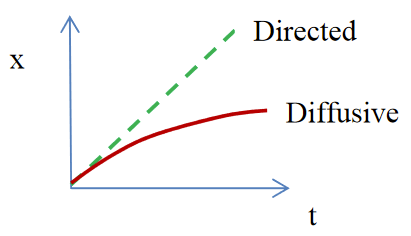15: Transporte Pasivo
- Page ID
- 69639
El transporte pasivo suele ser sinónimo de difusión, donde la energía térmica es la única fuente de movimiento.
\[ \langle r(t) \rangle = 0 \qquad \qquad \qquad \langle r^2(t) \rangle^{1/2}=\sqrt{6Dt} \qquad \qquad \qquad r_{rms}\propto \sqrt{t} \nonumber \]
 En los sistemas biológicos, el transporte difusivo puede funcionar a corta escala, pero no es efectivo para el transporte de largo alcance. Considerar:
En los sistemas biológicos, el transporte difusivo puede funcionar a corta escala, pero no es efectivo para el transporte de largo alcance. Considerar:
\( \langle r^2 \rangle^{1/2} \)para pequeñas proteínas que se mueven en el agua
~10 nm →10 —7 s
~10 μm → 10 —1 s
El transporte activo se refiere al movimiento dirigido:
\[ \langle r(t) \rangle = \langle v \rangle t \qquad \qquad \qquad \qquad r \propto t \nonumber \]
Esto requiere una entrada de energía en el sistema, sin embargo, aún debemos lidiar con fluctuaciones térmicas aleatorias.
¿Cómo se acelera el transporte?
Discutiremos estas posibilidades:
- Reducir la dimensionalidad: Difusión facilitada
- Gradiente de energía libre (potencial químico): Difusión en un potencial
- Direccional: Requiere entrada de energía, lo que impulsa la conmutación entre dos estados conformacionales de la partícula en movimiento ligada a la traslación.
- 15.2: Difusión facilitada
- La difusión facilitada es un tipo de reducción de dimensionalidad que se ha utilizado para describir el movimiento de los factores de transcripción y proteínas reguladoras que buscan su diana de unión en el ADN.

